-
current
recommendations- Liefdefjord
New page dedicated to one of Spitsbergen's most beautiful fjords. Background information and many photos.
- New Spitsbergen guidebook
The new edition of my Spitsbergen guidebook is out and available now!
- Liefdefjord
New page dedicated to one of Spitsbergen's most beautiful fjords. Background information and many photos.
Page Structure
-
Spitsbergen-News
- Select Month
- June 2025
- May 2025
- April 2025
- March 2025
- February 2025
- January 2025
- December 2024
- November 2024
- October 2024
- September 2024
- August 2024
- July 2024
- June 2024
- May 2024
- April 2024
- March 2024
- February 2024
- January 2024
- December 2023
- November 2023
- October 2023
- September 2023
- August 2023
- July 2023
- June 2023
- May 2023
- April 2023
- March 2023
- February 2023
- January 2023
- December 2022
- November 2022
- October 2022
- September 2022
- August 2022
- July 2022
- June 2022
- May 2022
- April 2022
- March 2022
- February 2022
- January 2022
- December 2021
- November 2021
- October 2021
- September 2021
- August 2021
- July 2021
- June 2021
- May 2021
- April 2021
- March 2021
- February 2021
- January 2021
- December 2020
- November 2020
- October 2020
- September 2020
- August 2020
- July 2020
- June 2020
- May 2020
- April 2020
- March 2020
- February 2020
- January 2020
- December 2019
- November 2019
- October 2019
- September 2019
- August 2019
- July 2019
- June 2019
- May 2019
- April 2019
- March 2019
- February 2019
- January 2019
- December 2018
- November 2018
- October 2018
- September 2018
- August 2018
- July 2018
- June 2018
- May 2018
- April 2018
- March 2018
- February 2018
- January 2018
- December 2017
- November 2017
- October 2017
- September 2017
- August 2017
- July 2017
- June 2017
- May 2017
- April 2017
- March 2017
- February 2017
- January 2017
- December 2016
- November 2016
- October 2016
- September 2016
- August 2016
- July 2016
- June 2016
- May 2016
- April 2016
- March 2016
- February 2016
- January 2016
- December 2015
- November 2015
- October 2015
- September 2015
- August 2015
- July 2015
- June 2015
- May 2015
- April 2015
- March 2015
- February 2015
- January 2015
- December 2014
- November 2014
- October 2014
- September 2014
- August 2014
- July 2014
- June 2014
- May 2014
- April 2014
- March 2014
- February 2014
- January 2014
- December 2013
- November 2013
- October 2013
- September 2013
- August 2013
- July 2013
- June 2013
- May 2013
- April 2013
- March 2013
- February 2013
- January 2013
- December 2012
- November 2012
- October 2012
- September 2012
- August 2012
- July 2012
- June 2012
- May 2012
- April 2012
- March 2012
- February 2012
- January 2012
- December 2011
- November 2011
- October 2011
- September 2011
- August 2011
- May 2011
- April 2011
- March 2011
- February 2011
- January 2011
- December 2010
- November 2010
- September 2010
- August 2010
- July 2010
- June 2010
- May 2010
- April 2010
- March 2010
- February 2010
- November 2009
- October 2009
- August 2009
- July 2009
- June 2009
- May 2009
- April 2009
- March 2009
- February 2009
- January 2009
- December 2008
- November 2008
- October 2008
- August 2008
- July 2008
- June 2008
- May 2008
- April 2008
- March 2008
- February 2008
- April 2000
- Select Month
-
weather information
-
Newsletter

| Guidebook: Spitsbergen-Svalbard |
Home
→ February, 2020
Monthly Archives: February 2020 − News & Stories
Svea Nord is history
Svea Nord was the largest coal mine ever in Spitsbergen. It belonged to the mining complex of Sveagruva in Van Mijenfjord, together with the settlement of Sveagruva itself, the harbour facilities at Kapp Amsterdam and the mine in Lunckefjellet.
The mine was opened in 2001. A coal seam thickness of up to 6 metres allowed an annual production of 3 million tons. Not recordbreaking on a global scale, but the largest amount that was ever achieved in any mine in Spitsbergen. This put the mining company Store Norske Spitsbergen Kulkompani in a good economical situation for some years around 2008.
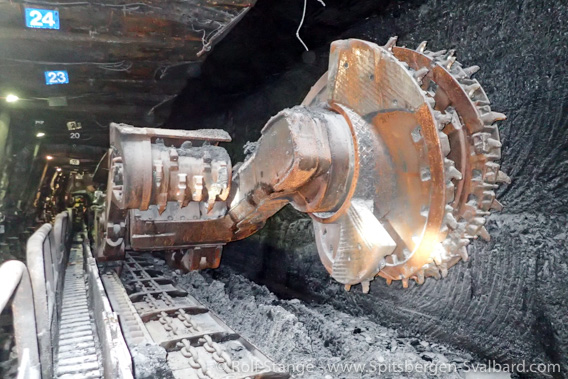
The longwall-method could be used very economically in Svea Nord with a coal thickness of 4-6 metres.
Then, prices on the world markest went downhill and the economical situation became difficult for the coal mines in Spitsbergen. Job cuts and a struggle for funding further mining operations were the theme of the day in 2013 and following years. The Norwegian government, owner of Store Norske, helped initially out but then decided in 2015 to put mining in Sveagruva on hold. In 2017 the decision followed to abandon all mining activities there altogether, including a removal of the mines and the settlement – a unique step in the history of Spitsbergen.
The mine in Lunckefjellet was closed already in early 2019. This mine was ready for productive operation in 2013, but the productive stage was never actually reached in Lunckefjellet.
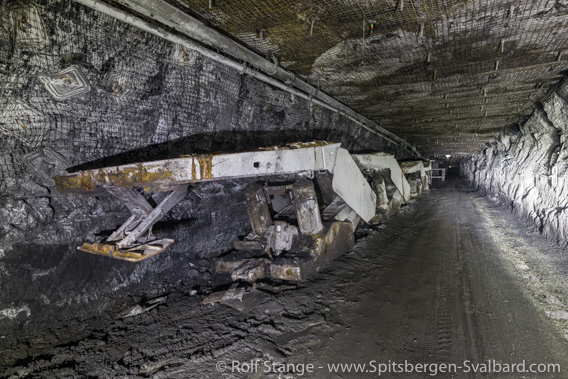
Tunnel in Svea Nord, with mining equipment ready to be removed before the mine is closed.
Now the large mine of Svea Nord is about to be closed. A lot of materials and equipment have been removed and will be shipped out. According to the plan, Svea Nord will be closed for good in March 2020.
At the same time, the clean-up of the settlement of Sveagruva is making progress. Apart from a few old artefacts that are protected as part of the historical heritage of the area, everything is supposed to be removed. In the end, only careful observers should be able to see that people lived here for decades and that this area was the site of industrial mining for almost a century. But there is still a way to go. Closing Svea Nord is a significant step within this process, and it is quite unique in the context of arctic mining: in the 20th century, it was common just to leave things just where they were unless they were valuable enough to remove them.
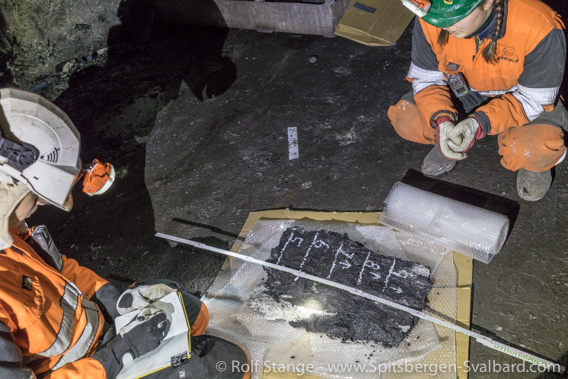
The very last pieces of coal that have left Svea Nord will serve scientific purposes. Geologist Malte Jochmann and mining engineer Kristin Løvø at work (December 2019).
In December 2019, I had the opportunity to visit Svea Nord together with a team of geologists. While they were taking smaples, I had the chance to do some photography, capturing some impressions of Spitsbergen’s largest coal mine. As a result, I have created a page with photo galleries and panoramas of Svea Nord to make it at least virtually accessible for everybody while the mine is physically closed and inaccessible forever. There is actually a set of several pages, also including Sveagruva (settlement), Lunckefjellet (mine) and Kapp Amsterdam (harbour). They are all accessible through an overview page Svea area (click here).
Avalanche accident at Fridtjovbreen: two persons dead
Two people, both of German nationality, were killed during an avalanche accident at Fridtjovbreen, a glacier south of Barentsburg. Both were travelling as part of a guided group of the Arctic Travel Company in Barentsburg. When Norwegian rescue forces arrived on the scene, they could only declare both persons dead.
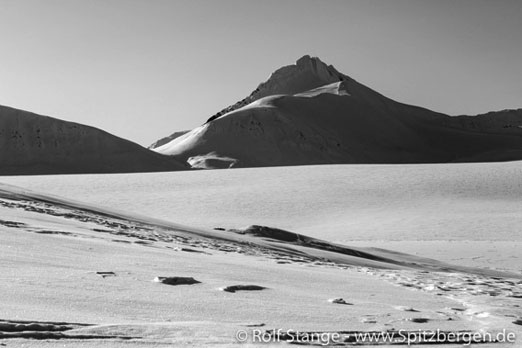
The Norwegian authorities are informing the relatives of the victims and will investigate the accident. The community of Longyearbyen has established a crisis team to help all people in Barentsburg and Longyearbyen who might be in need.
Polar bear weighed only 62 kg
The polar bear that died in late January during transportation in a helicopter weighed only 62 kg as first results of the post mortem revealed. This means that the bear must either have been very small or extremely thin. Even a small, sub-adult female should have more than 100 kg. Even a second year cub should weigh significantly more than 60 kg, and it should still be with its mother then. A first year cub would not be able to survive on its own, without the mother.
Also chances for survival for a (sub)adult polar bear with a weight of only 62 kg would have been doubtful at best.
This is currently, however, speculation. Further details of the post mortem, which will hopefully enable specialists to draw conclusions regarding the cause of death, will only be available in several weeks.

Young polar bear together with its mother. The little bear was about 20 months old at the time the picture was taken and its weight was certainly well above 60 kg.
There is also new information regarding the polar bear visits to Longyearbyen in late December: DNA analysis of various samples revealed that it were at least two individuals who came close to and into the settlement then.
100 years Spitsbergen Treaty
The Spitsbergen Treaty was signed exactly 100 years ago, on 09 February 1920, in Versailles. The contract secured suverenity over the Spitsbergen islands but includes several limitations. Click here to read more about the treaty itself on the page dedicated to the treaty within this website.
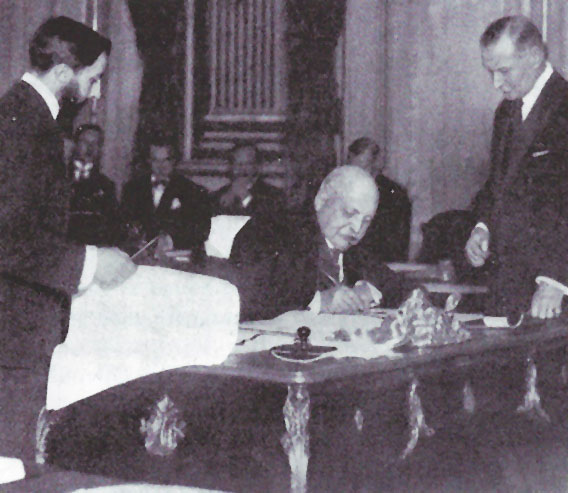
Fredrik Wedel Jarlsberg, Norwegian ambassador in Paris,
signs the treaty on 09 February 1920 in Versailles.
The Spitsbergen Treaty was negotiated over several months in Versailles in 1919. Fredrik Wedel Jarlsberg was leading the negotiations on behalf of Norway, but others including Fridtjof Nansen had been part of the political work that had paved the way to the treaty over years.
Today, the treaty is often referred to as the Svalbard Treaty, but the original treaty text does not include the word “Svalbard” at all.
Overlapping private territorial by a number of mining companies from various countries had to be sorted before the treaty could enter force. This happened finally on 14 August 1925, when the “Svalbard law” (Svalbardloven) came into force in Norway, turning the treaty into national law.
The treaty is still in force. There are some disputes regarding the use of marine resources (fishing, oil, gas, other mineral resources) outside the 12 mile zone, but within the 200 mile zone around Svalbard. The concept of these zones was defined much later and they were not part of the treaty, which hence leaves room for different interpretations, depending on whom you ask. Norway claims that the principle of nondiscrimination (equal rights for everybody regardless of nationality) is valid only within the 12-mile zone, but claims exclusive rights in the 200-mile economical zone (outside the 12-mile zone). Other countries do not agree, namely Latvia which was up to now the last country that entered the Spitsbergen Treaty on 13 June 2016 (a few months after North Korea) and Russia. Russia’s ministry of foreign affairs has just recently again released a press note claiming to be unhappy about restrictions of Russian activities in Spitsbergen and expects Norway to accept bilateral talks, something that Norway has never accepted in the past.
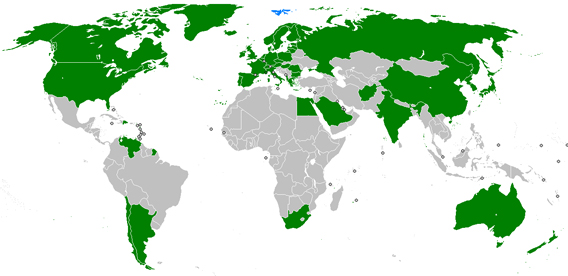
Signatory countries in the Spitsbergen Treaty.
Today, 100 years after the treaty was signed in Paris on 09 February 1920, a number of events and lectures are dedicated to the treaty in Longyearbyen, Norway and other countries.
News-Listing live generated at 2025/June/15 at 15:57:42 Uhr (GMT+1)




























